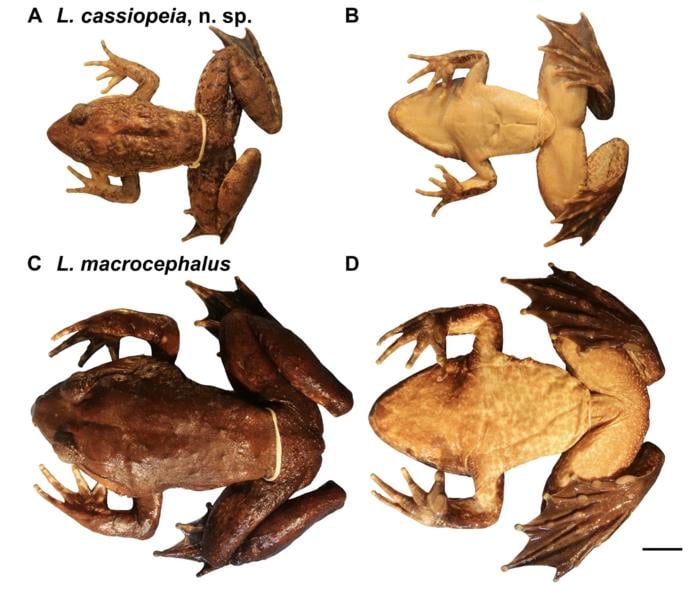Summary: Researchers from the University of Kansas have identified a new species of fanged frog on Luzon Island, Philippines, which had been overlooked for decades due to its similarity to a larger, well-known species.
Estimated reading time: 7 minutes
A team of researchers from the University of Kansas has uncovered a new species of fanged frog on the Philippine island of Luzon, challenging our understanding of biodiversity in well-studied areas. The newly described species, named Limnonectes cassiopeia, had been hiding in plain sight for over two decades, mistaken for juveniles of the larger Luzon Giant Fanged Frog.
Why it matters: This discovery highlights the importance of continued biodiversity research, even in areas thought to be well-explored. It demonstrates that new species can be found in unexpected places, including densely populated regions, and emphasizes the need for thorough genetic and morphological studies to uncover hidden diversity.
Unraveling the Mystery of the Fanged Frogs
Fanged frogs are unique amphibians found in Southeast Asia, known for the large, bony protuberances in the lower jaws of males. Mark Herr, lead author and doctoral student at KU’s Biodiversity Institute and Natural History Museum, explains, “They’re called that because the males of some species have large, bony protuberances, like fangs, in their lower jaw — it’s pretty unique. It’s still a bit of a mystery, but it’s become generally assumed that these fangs are used for male-to-male combat.”
The discovery of Limnonectes cassiopeia came about during a broader genetic survey of Philippine fanged frogs. Herr found a distinct genetic cluster that didn’t match the two known species on Luzon Island: the large Limnonectes macrocephalus and the medium-sized Limnonectes woodworthi.
This genetic revelation prompted a closer examination of museum specimens, leading to the identification of subtle morphological differences that distinguish the new species from its larger counterpart.
A Hidden Difference in Plain Sight
The key to differentiating Limnonectes cassiopeia from the Luzon Giant Fanged Frog lies in a seemingly minor detail: the color and size of its toe pads. Herr describes his breakthrough: “Not only are the toe pads smaller, but they’re white. They’re pale, completely unpigmented, which sets them apart from the primary species, Limnonectes macrocephalus, which has dark gray pigmented toe pads.”
This distinction is particularly remarkable given that these frogs have been caught and studied for over a century on Luzon, an island more densely populated than Great Britain. The oversight highlights the challenges of identifying new species based solely on physical appearance, especially when they closely resemble known species.
Developmental Differences and Future Research
Beyond the toe pad coloration, researchers found that Limnonectes cassiopeia develops its characteristic large head earlier in its life cycle compared to Limnonectes macrocephalus. This developmental difference provides another means of distinguishing between the two species.
The discovery opens up new avenues for research into the behavior and ecology of Limnonectes cassiopeia. Herr is eager to explore how the new species might differ from its larger relative in the wild. “Now that we know they’re different, we can go out and watch them and study their natural history and detail. Maybe they’re doing something totally different in the wild, you know? That’s exciting for me,” he says.
Implications for Biodiversity Research
The identification of Limnonectes cassiopeia underscores the importance of combining genetic analysis with traditional morphological studies in biodiversity research. It demonstrates that even in well-studied areas, new species can be overlooked when they closely resemble known organisms.
This discovery also raises questions about potential cryptic species – morphologically similar but genetically distinct organisms – in other parts of the world. It highlights the need for ongoing, detailed biodiversity surveys, even in areas presumed to be well-documented.
As human activities continue to impact natural habitats, understanding the full extent of biodiversity becomes increasingly crucial for conservation efforts. The case of Limnonectes cassiopeia serves as a reminder that there may be many more species yet to be discovered, hiding in plain sight.
Quiz:
- What is the name of the newly discovered fanged frog species?
- What key physical characteristic distinguishes the new species from the Luzon Giant Fanged Frog?
- On which Philippine island was the new frog species discovered?
Answer Key:
- Limnonectes cassiopeia
- White, unpigmented toe pads
- Luzon Island
If our reporting has informed or inspired you, please consider making a donation. Every contribution, no matter the size, empowers us to continue delivering accurate, engaging, and trustworthy science and medical news. Independent journalism requires time, effort, and resources—your support ensures we can keep uncovering the stories that matter most to you.
Join us in making knowledge accessible and impactful. Thank you for standing with us!

